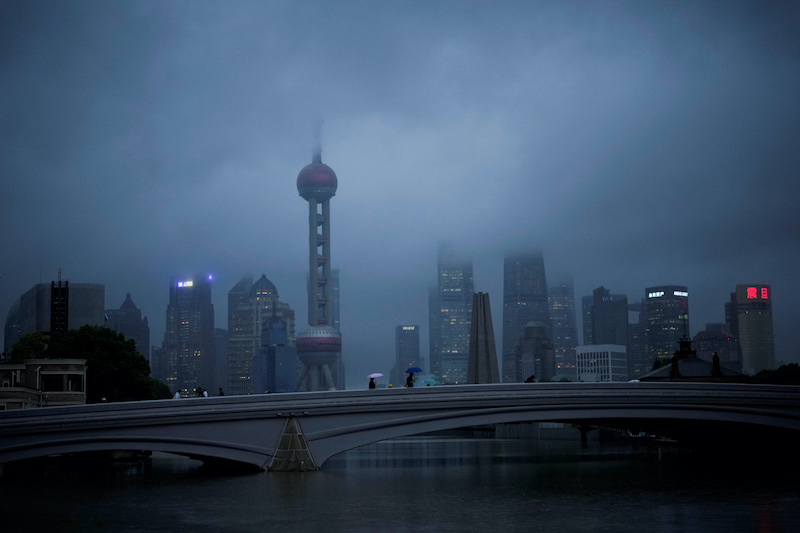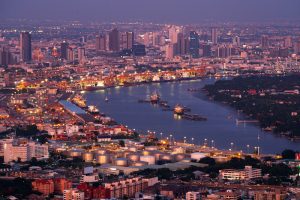Typoon Muifa – the strongest tropical cyclone to hit the Yangtze River Delta in a decade – was downgraded by Chinese weather forecasters to a strong tropical storm on Thursday.
But concern remains over the heavy rains and flash flooding it will bring as it heads north of Shanghai to several populated coastal provinces.
Powerful gales and torrential rains battered the port city of Zhoushan, just south of Shanghai, on Wednesday night when Muifa made landfall at about 8:30pm (1230 GMT).
The storm had maximum wind speeds near its centre reaching 42 metres per second, according to state forecasters. That’s about 150 km per hour (94 mph) – powerful enough to damage homes, topple trees and down power lines.
After spinning across Hangzhou Bay it hit Shanghai around midnight, before continuing its northerly track to the provinces of Jiangsu and Shandong, forecasters said.
Its path through the Yangtze River Delta crossed a cluster of big cities with a total population of more than 230 million.
The Yangtze Delta is also China’s most prosperous region, with Shanghai the nation’s financial and commercial capital and neighbouring cities important centres of industry. The Ningbo-Zhoushan port and port of Shanghai are among the busiest in the world by cargo tonnage handled.
Flights at Zhoushan and Ningbo airports, in the coastal province of Zhejiang, were cancelled, while the ship bunkering hub shared by both cities suspended discharging and loading oil as tankers took shelter at anchorages.
All flights were cancelled at Shanghai’s busy Pudong and Hongqiao airports as a precaution.
The mega city of 25 million people took safety measures a step further by limiting speeds for ground elevated trains or even closing stations, and warned of train delays to ensure safety in affected areas while keeping other sections operating.
Shanghai’s numerous outdoor Covid testing sites were also shut, in a rare disruption to an entrenched testing regime since a citywide lockdown was lifted in June.
ALSO SEE: China Property Stocks Soar on Hope of More Home Price Cuts
Zhejiang authorities issued a “red warning” for flash floods in several areas, the highest warning level in China’s four-tier typhoon warning system.
More than 1.14 million people in Zhejiang were relocated ahead of the storm, according to local media.
Meteorologists said Muifa was caused by this year’s unusually hot weather and high temperatures in the East China Sea, Chinese financial magazine Caixin reported.
Despite the suspension of much commercial activity, and port activities grinding to a halt, there was little damage reported. However, some photos on China’s Twitter-like social media platform Weibo showed shallow-rooted curbside trees uprooted and fallen leaves carpeting roads.
Travelling at a speed of 20-30 km per hour (12-19 miles per hour) in a north-westerly direction, Muifa is now expected to skirt along the eastern coast of Jiangsu province and cross the Shandong peninsula, the China Meteorological Administration said.
Heavy rains will hit northeastern Jiangsu, the central and eastern areas of Shandong, central and eastern areas of Liaoning province, and southeastern Jilin province, forecasters said.
Various areas could see maximum hourly rainfall of 30 to 60 mm (1 to 2 inches), with some localities exceeding 70mm.
Forecasters raised advisory warnings in several provinces for flash flooding at rivers and landslides.
The last storm of this size was Typhoon Damrey in 2012, which made landfall in Jiangsu province north of the Yangtze, which killed dozens in its path, destroying tens of thousands of homes and causing billions of yuan in direct economic losses.
The development of advanced warning systems in the years since are widely seen as greatly reducing the death toll and devastation that such storms used to cause.
- Reuters with additional editing by Jim Pollard
ALSO SEE:
Chinese Cities Cancel Hundreds of Flights as Typhoon Nears
Record High Temperatures, Floods Wreak Havoc Across China
China Faces Economic Hit From Extreme Weather in July, August
























